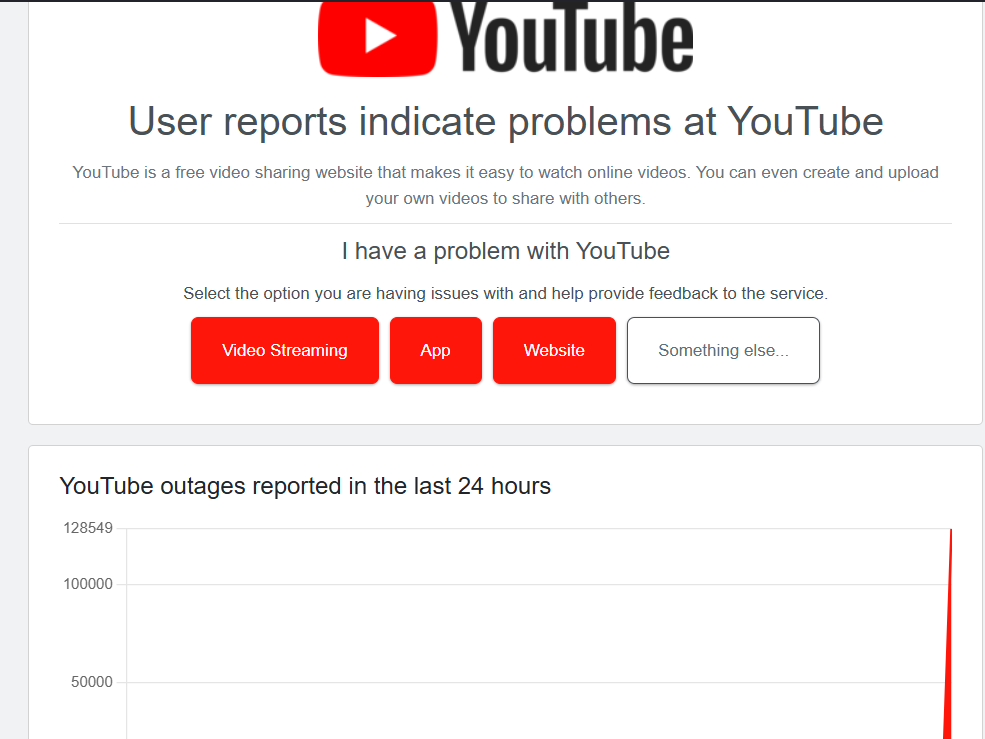
YouTube Down Outage Causes: Imagine settling in for your evening routine, ready to catch up on the latest videos, only to be met with a spinning wheel or an error message. This scenario became all too real for millions when YouTube down struck globally on October 15, 2025. Such interruptions remind us how reliant we’ve become on this platform for entertainment, education, and even work. In this article, we’ll explore the ins and outs of these outages, from their causes to their effects, and offer some handy advice for the next time it happens.
YouTube Down Outage Causes: Incident October 2025 Breakdown
Just yesterday, on October 15, 2025, YouTube experienced one of its most significant outages in recent years. Starting around 7 PM ET, users worldwide reported issues with video playback, blank homepages, and problems accessing YouTube Music and YouTube TV. At its peak, Downdetector recorded over 366,000 user reports in the U.S. alone, with thousands more from the UK, Canada, and Australia. People saw messages like “An error occurred. Please try again later,” accompanied by cryptic playback IDs.

The disruption lasted about two hours for most, though some lingered into October 16. Google quickly acknowledged the problem via their TeamYouTube account on X, stating they were investigating and working on a fix. By around 9 PM ET, services began recovering, and an official statement confirmed the resolution without detailing the exact cause. However, this event wasn’t isolated; it echoed patterns from previous downtimes.
For instance, users in major cities like New York, London, and Toronto felt the brunt, as outage maps highlighted hotspots in these areas. Additionally, the timing couldn’t have been worse, coinciding with peak evening hours when viewership surges. As a result, social media buzzed with frustration, memes, and alternative suggestions. But why do these happen? Let’s dig deeper.
YouTube Down Outage Causes: A Historical Look at YouTube Outages
YouTube’s history is dotted with outages, some brief and others monumental. The platform, owned by Google since 2006, has grown massively, but so have its vulnerabilities. One of the earliest major incidents occurred on February 24, 2008, when a Pakistani telecom’s attempt to block YouTube locally accidentally went global via a routing error, knocking it offline for two hours worldwide.
Fast forward to October 16, 2018 – interestingly, the same date as a later event – YouTube went down for over an hour, displaying 500 and 503 errors to users trying to watch videos or access music services. Then, in 2020, a trifecta of disruptions hit: August saw a six-hour global outage affecting Gmail and Drive alongside YouTube; November brought playback loops and errors; and December’s 50-minute blackout impacted nearly all Google services due to an authentication system failure.
More recently, August 8, 2022, saw slow loading and 500 errors across Search, Maps, and YouTube from a software update gone wrong. And in 2023, YouTube TV failed during the final minutes of an NBA playoff game, leaving sports fans furious. Earlier this year, on September 4, 2025, all Google services, including YouTube, were inaccessible in Turkey and Eastern Europe.
These events show a pattern: while rare, outages often stem from internal glitches or external factors. For example, the 2013 five-minute total Google shutdown caused a 40% drop in global internet traffic. Overall, they’ve become less frequent as infrastructure improves, but when they occur, the scale is immense given YouTube’s billions of users.
YouTube Down Outage Causes: Common Causes When YouTube Goes Down
So, what triggers a YouTube down situation? Often, it’s a mix of technical hiccups. Software bugs, like the 2014 configuration error or 2022’s update issue, are frequent culprits. Server overloads during high-traffic events, such as live streams or viral moments, can also strain systems.
Moreover, external factors play a role. Cyberattacks, though Google rarely confirms them for YouTube specifically, have plagued other platforms. Power failures, like the 2024 Google Cloud incident in Germany, can cascade effects. Network routing errors, as in 2008, highlight how interconnected the internet is.
Additionally, maintenance gone awry or human error contributes. In the recent October 2025 case, while not specified, reports suggest it might have been an internal service disruption. Understanding these helps demystify the chaos, but the real question is how it affects everyday people.
The Broader Impact of YouTube Outages
When YouTube down hits, the ripple effects are profound. For casual viewers, it’s a minor annoyance – perhaps switching to Netflix or TikTok. However, for creators, it’s a revenue killer. With ad earnings tied to views, even short downtimes can cost thousands. During the 2020 December outage, many reported lost income from interrupted uploads and streams.
Businesses relying on YouTube for marketing or tutorials face disruptions too. Educators using it for classes, especially in remote learning eras, scramble for alternatives. On a societal level, outages during key events – like the 2018 World Cup or 2023 NBA finals – amplify frustration, turning to social media vents.
Economically, Google’s stock can dip slightly, though recoveries are swift. Psychologically, it underscores our digital dependence, prompting reflections on offline activities. Nevertheless, these incidents push for better resilience.
Practical Steps: What to Do When YouTube is Down
First, check if it’s widespread. Sites like Downdetector or DownForEveryoneOrJustMe are invaluable. If confirmed, patience is key – most resolve quickly.
Meanwhile, try basics: refresh the page, clear cache, or switch devices/browsers. Use a VPN if regional issues suspect. For entertainment, pivot to Vimeo, Twitch, or downloaded content.
Creators: Schedule posts wisely and diversify platforms. Businesses: Have backups like embedded videos on sites. Proactively, enable notifications from @TeamYouTube for updates.
In summary, preparation eases the blow.
Looking Ahead: Mitigating Future YouTube Down Events
Google invests heavily in redundancy, with data centers worldwide. AI monitors for anomalies, and post-mortems improve systems. Yet, perfection is elusive in tech.
Users can advocate for transparency via feedback. As YouTube evolves with features like Shorts, robustness must keep pace.
Ultimately, while outages like the recent one disrupt, they highlight the platform’s importance. Next time YouTube down trends, you’ll be ready.



